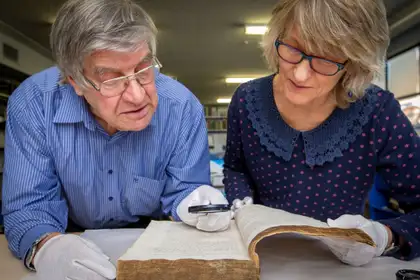
Dr John Ross and Dr Pauline Knuckey with manuscript.
For several years the nondescript cardboard file box lay on a shelf gathering dust, largely ignored and overlooked by the office's occupants. That all changed one day in 1977, when Dr John Ross, a lecturer in the English Department, decided to peep inside it.
“I was astounded and very excited,” he recalls, on seeing the contents. Instead of finding discarded textbooks, he came across a rare early 17th century manuscript book. The manuscript is a translation into English, from Latin, of Francois Feu-ardent’s Dialogi Septem (1594). Its dedicatory epistle is signed “G.B.” and dated “from London this first of January, 1603”.
After seeing the neat, hand-written manuscript and reading the dedicatory epistle, Dr Ross suggested the translator could be George Brown, who has been proposed as the translator into English of Vincenzio Puccin's The Life of the Holy Mother Suor Maria Maddalena de Pazzi (1619), although this attribution has been disputed.
“It is likely, though not certain, that It was indeed translated and handwritten by George Brown, who was a prominent English Catholic,” Dr Ross says. “It is all very neat, not hurried and it would have taken possibly a year or two to translate and write.
“The original, in Latin, was first published in 1594, nine years earlier, and the manuscript we have is the one and only copy in the world. It is a unique document and it is Massey that has it – that is what is so extraordinary.”

Dedicatory epistle dated January 1603.
Special Collections librarian Dr Pauline Knuckey says the manuscript’s provenance is explained, to some degree, by correspondence that accompanies it.
“In a letter dated March 1968 from Reginald Tye of Victoria University, to Roderick Lyall, a member of Massey’s English Department, Tye explains the manuscript came from Ireland to the Cistercian monastery at Kopua, near Takapau, where he obtained it from the monastery’s Abbot. He describes the item as ‘a fairly routine Vade mecum [hand book] for the recusant clergy, through an excellent introduction to court hand’.”
The Massey University Library has recently digitised the manuscript, which is now on its digital repository Tāmiro.
“While the manuscript lacks its boards, title leaf and at least one leaf of the dedicatory epistle, it is a unique item and the Library is delighted to have it as part of its collection and to be able to share it widely via Tāmiro,” Dr Knuckey says.
For those who want to see the original item, please contact Pauline Knuckey at p.m.knuckey@massey.ac.nz or phone 06 951 9115.
Dr Ross was a member of the English Department, later part of the School of English an Media Studies, from 1973 to 2001.